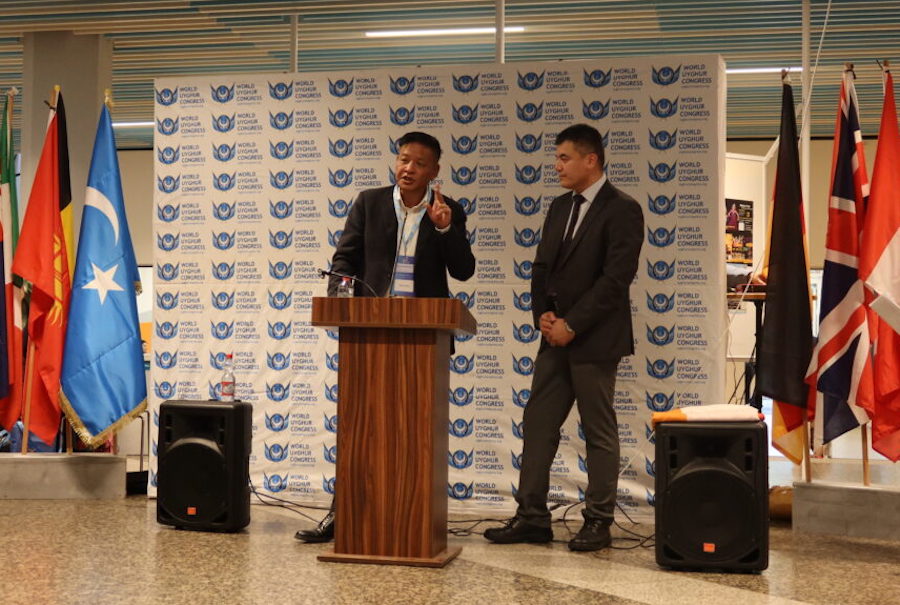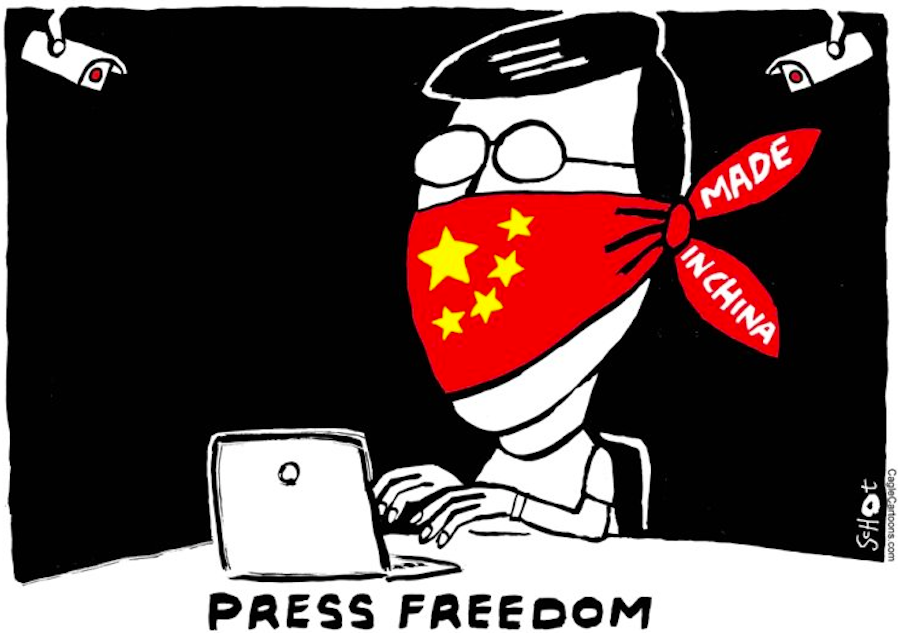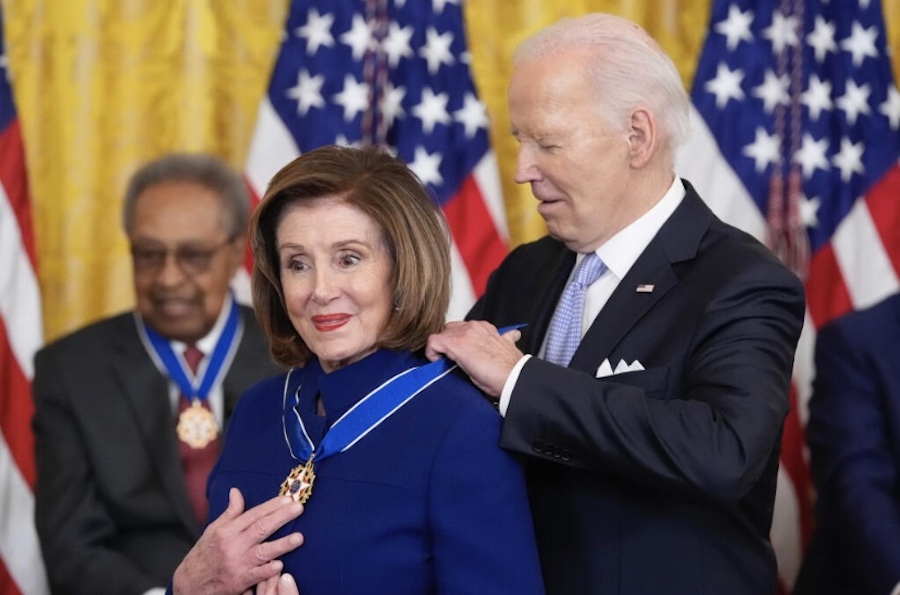PART I
By Julian Gearing
 DHARAMSALA, India and KATHMANDU, Nepal – When astronaut Yang Liwei rocketed into space on China’s first manned spaceflight, he carried with him the 2008 Beijing Olympic Games banner and China’s national flag. Just like the spaceflight, China’s award of the Olympic Games represents the coming of age for this growing world superpower.
DHARAMSALA, India and KATHMANDU, Nepal – When astronaut Yang Liwei rocketed into space on China’s first manned spaceflight, he carried with him the 2008 Beijing Olympic Games banner and China’s national flag. Just like the spaceflight, China’s award of the Olympic Games represents the coming of age for this growing world superpower.
On this historic flight the Olympic Games logo was flown high. But the Chinese government fears that the banner will be dragged through the dirt by protestors when the games begin. “Free Tibet” and human rights agitators are gearing up to protest, and the government does not want their glorious sports epic sullied by dissent at home or abroad.
Face matters to the Chinese government. Looking good for the Olympic Games is one of the reasons why the Tibetan “exile government” in the Indian Himalayan hill station of Dharamsala believes that there is a chance of winning a deal that will allow the Dalai Lama and his exiled people to go home.
 In the guessing game being played by Tibetan exile politicians to work out why the Chinese government has recently opened up to dialogue on the Tibet issue after years of shut doors, the Olympics is one of the factors that has come into play. Samdhong Rinpoche, the exile government’s kalon tripa or prime minister, understands that looking good for the Olympic Games matters to Beijing. He said that the growth in international public support for the “Tibet Cause”, and the realization that working out a deal could prove beneficial to both sides, is helping to drive the new willingness to dialogue.
In the guessing game being played by Tibetan exile politicians to work out why the Chinese government has recently opened up to dialogue on the Tibet issue after years of shut doors, the Olympics is one of the factors that has come into play. Samdhong Rinpoche, the exile government’s kalon tripa or prime minister, understands that looking good for the Olympic Games matters to Beijing. He said that the growth in international public support for the “Tibet Cause”, and the realization that working out a deal could prove beneficial to both sides, is helping to drive the new willingness to dialogue.
As China aims for superpower stardom, its leaders continue to be dogged by Western protests over their treatment of Tibet, which began in 1950 when China invaded the Buddhist kingdom. Although the massive pro-business and pro-China lobbies in the United States and Europe have prevented even a whiff of a suggestion that sanctions should be imposed on China, over the past two decades there has been major growth in the “pro-Tibet” lobby.
Since the Dalai Lama won the Nobel Peace Prize in 1989, the call for change in Tibet by Western politicians, activists, pop stars and actors has grown to the point where the subject of Tibet crops up at many high-level meetings between Western leaders and Beijing. The European Union even went as far as sponsoring a resolution in 2000 calling for the recognition of the Tibetan exile government as the legitimate government of Tibet within three years if there was no progress on human rights in the territory. That resolution has been put on hold following the recent resumption of the Sino-Tibetan dialogue.
Beijing appears particularly troubled by international support for the Tibetan spiritual leader. “The Chinese leaders are very afraid of the Dalai Lama and have been shocked by the international response to his calls,” said Sonam Topgyal, a senior Tibetan exile politician. Beijing calls him a “splittist”, a “separatist”, even a “devil” and a “cannibal”. But this “simple monk”, as he calls himself, continues to attract the handshakes of world leaders, and recently tens of thousands of people to a talk he gave on Buddhism and peace in Central Park, New York.
China realizes a new approach is needed. Lodi Gyari and Kelsang Gyaltsen, the two envoys of the Dalai Lama who are dealing with China, sense a change in Chinese attitude. Gyari was part of a team that visited China and Tibet in the 1980s. Back then, he reportedly found the Chinese attitude rude and deaf to the Tibetan point of view. Now the Chinese side is being courteous and listening. The envoys visited China and Tibet in September 2002 and May this year in what was described by the Tibetan exile government as “encouraging” visits.
This dialogue is just the start, or “talks about talks”, as one Tibetan exile government official put it. Samdhong Rinpoche said that hopes are pinned on the next visit of the envoys during which “substantial negotiations” can begin into the status of Tibet and the future of the estimated 6 million Tibetans in the Tibetan Autonomous Region and the Tibetan parts of neighboring Sichuan and Qinghai provinces, what the exile government calls “greater Tibet”.
No deal is on the table yet. But what is clear is that the gap between the Dalai Lama’s exile government and Beijing has narrowed. On a recent visit to the United States, Chinese Premier Wen Jiabao was heckled at Harvard Business School by an American protestor shouting “Free Tibet”. Such protests now seem to embarrass the Dalai Lama’s exile government rather than cause them to smile. The Dalai Lama has dumped the idea of independence. Now he calls for a “middle path” to autonomy, and a very limited form of autonomy at that.
The Tibetan exile government is calling for a degree of self-rule in Tibet that would protect the cultural and religious identity of the Tibetans and offer a mechanism to allow the 130,000 exiled Tibetans to return home, but keep defense, foreign affairs and the economy under Beijing’s control. The Dalai Lama has said he wants no political position – he claims he is already “semi-retired”, having handed over his executive powers to premier Samdhong Rinpoche. According to Tibetan exile parliament speaker Pema Jungney, their exile government envisages a situation where Tibet would be under the control of China, but with a different system of government, like in Hong Kong.
On the Chinese side, the form of autonomy they have offered is tightly limited. Their stance was voiced by former president Jiang Zemin when he outlined a vision little different than the communist party rule currently seen in the Tibetan region, with the opportunity for the Dalai Lama to live in Beijing with an honorary title.
Jiang and former communist party boss in Tibet Guo Jinlong were the leaders who opened the doors to dialogue, according to Thierry Dodin, director of the Tibet Information Network in London. Now the ball is in President Hu Jintao’s hands. Hu understands the challenges. He served as Communist Party secretary in Tibet from 1988 to 1993, said Dodin. But while Tibetans are pinning their hopes on Hu, his policy during his tenure in Tibet was to “open up to economic development, but stamp down on separatism”. This was starkly shown in 1989, when he brutally clamped down on a Tibetan demonstration for independence in the capital Lhasa.
Hu has been dubbed “hard-line”, but still the Tibetans feel he may help. Tibetan exile premier Samdhong Rinpoche said: “There are a few strong Chinese leaders who want to solve the Tibet issue as early as possible and during the active lifetime of the Dalai Lama. But they are not able to come out forcefully because they are not certain whether they would be opposed.” He said the reception of the Tibetan envoys suggests these leaders are consolidating their own position before they make a move, ever mindful of the danger of being stabbed in the back by enemies within their own Communist Party ranks.
“These leaders need to be on solid ground,” Samdhong Rinpoche said. “Up until recently, the Chinese considered policies just to delay until the Dalai Lama passes away, under the banner of ‘keep the banner of negotiation high and stop the Dalai Lama from returning’.” Now there are some powerful leaders who recognize the need to deal with Tibet before it becomes violent like the situation in Sri Lanka or the Middle East, he said. Such a situation would not be easy for China to handle, he added.
Tibet observers say that China could swiftly crush violent dissent, but that this would have a very negative fall-out internationally.
Are the Chinese leaders’ efforts genuine? Or is this just a bluff to defuse opposition and the Western grumbles about Tibet in the run-up to the Olympics? China watchers are in two minds. This could be a genuine effort to solve the problem by younger and more liberal leaders. Or it’s a sham. Professor Colin Mackerras of Griffith University in Australia says the Chinese position has to be understood against the background of China’s growing influence globally, both economically and strategically. He said the Chinese and their supporters in Tibet “would like to see a rapprochement, because it would reduce the extent of the tension in Tibet and lessen the extent of the long-standing international thorn in their side, but they can afford to wait.
“From their point of view, things are going quite nicely in Tibet at present,” Mackerras said, referring to the growing consolidation of control over the region and the economic and infrastructure development. This includes the building of the Golmud-Lhasa railroad, and the continuing influx of “outsiders”, mostly Han and Muslim Hui migrants, who reportedly are close to outnumbering the local Tibetans.
While the Tibetan exile government puts a good face on the dialogue, some Tibetans are skeptical. One high Tibetan lama claimed the Dalai Lama’s “middle path” to autonomy rather than striving for independence is a “sell-out”. He expressed distrust of the Chinese leadership, claiming there was little evidence to show they have budged from their hard line of “no deal” on Tibet.
The skepticism is warranted. But the options for the Tibetans are limited. And time is not on their side. Senior Tibetan exile politician Topgyal said that opting for autonomy was more achievable that aiming for independence. This makes even more sense given the Dalai Lama’s age. He’s 68. The Tibetan leader may joke that there could be 100 reincarnations of the Dalai Lama to carry on negotiations for a settlement of the Tibet issue. But the reality is this incarnation has done an incredible job of bringing the issue to world attention and keeping it there.
With the Beijing Olympic Games less than five years away, there is a good chance the world will see progress in the dialogue between the rising superpower and the Tibetan exiles. Maintaining face demands that. But whether this is really the “end game” in which the Dalai Lama gets to go home or a feint to deceive the world remains to be seen. As Tibetan exile premier Samdhong Rinpoche put it: “There is an old Tibetan saying, ‘the Tibetans are deceived by hope; the Chinese are deceived by doubt’.” Given the gap, one can only question whether there will ever be a meeting of minds.









